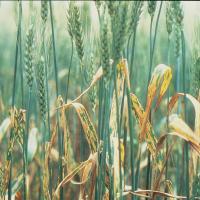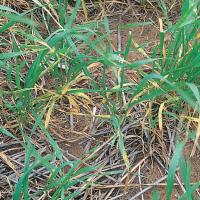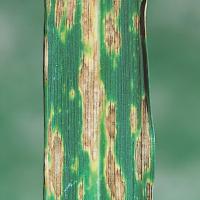Diagnosing yellow spot of wheat
Yellow spot is a stubble-borne fungal leaf disease of wheat caused by Pyrenophora tritici-repentis. It occurs commonly throughout the Western Australian wheatbelt and can reduce grain quality and cause yield losses of up to 30%.
What to look for
- Yellowing leaves, dying back from tips and scattered through a paddock.
Paddock
- Yellow-tan oval spots or lesions on leaves that become tan-brown in their centre with a yellow edge as lesions grow.
- Lower leaves affected in young crops on wheat stubble.
- Lesions expand, coalesce and produce large areas of yellow and necrotic diseased tissue.
- Severely diseased leaves will die back from the tip as lesions merge and leaves will die prematurely.
- On stubble, look for small raised black fruiting bodies, with microscopic hair-like projections, which feel rough when rubbing finger along stubble surface.
Plant
What else could it be
| Condition | Similarities | Differences |
|---|---|---|
| Diagnosing septoria tritici of wheat | Tan blotches with yellow margins | Septoria tritici has irregular, often inter-veinal, lesions that contain brown-black pinhead sized fruiting bodies (pycnidia) within the lesion |
| Diagnosing septoria nodorum of wheat | Tan blotches with yellow margins | Septoria nodorum has oval to irregular lesions which may lack the conspicuous yellow halo. Septoria nodorum can cause dark lesions on the head and glumes. It is important to note that yellow spot cannot easily be distinguished from septoria nodorum with the naked eye |
Where did it come from?

Contaminated stubble
- Yellow spot survives on wheat stubble.
- After rain, fungal spores are ejected from sexual fruiting bodies on stubble onto nearby seedlings. Secondary generation of asexual spores occurs on blotched leaves which are then widely dispersed on wind, infecting new leaves or other wheat paddocks.
- Continuous wheat crops and retaining stubble significantly increase the risk of this disease. Early sown susceptible varieties and extended wet conditions can result in an increased disease severity.
Management strategies

Spraying foliar

Rotation

Resistant varieties

Spraying foliar
- Generally application of foliar fungicide to manage yellow spot or septoria diseases is more likely to be economic when:
- 1. There is a good chance of follow-up rain of 100 mm or more rainfall after crop flag leaf emergence.
- 2. When applied at or around flag emergence (Z39) to protect the flag and flag-1 leaves, which contribute the most to filling grain.
- Other treatment options:
- Crop rotation with any non-host crop (e.g. barley, canola, lupins, oats, pulses).
- Reduce surface wheat stubble before seeding wheat after wheat.
- Sow varieties with higher levels of resistance.
- If disease is severe early, consider a foliar fungicide spray around first node (Z31), a second spray may be required around flag leaf emergence.
Economic and financial considerations
To assist in assessing the economic risk and financial costs associated with various treatment strategies use YellowSpotWM or go to MyEconomicTool.
There may be other economic and financial implications that need to be considered when choosing a management option. These may include:
Pre-crop- Assess the risk of yellow spot occurring.
- Understand the potential yield losses associated with infection.
- Assess the costs and benefits of taking preventative action.
- Compare the costs, benefits and risks of each management option against doing nothing.
- Consider risk and associated costs or savings of delaying treatment.
- Consider the potential risk of re-infection and costs of further treatment.
- Ignore all previous treatment costs in assessing current management options.
- Undertake a ‘what if’ scenario analysis to see what impact changing variables (e.g. grain price and seasonal conditions) have on the economic outcome.
- Consider longer term consequences of not adequately treating yellow spot.
View these economic considerations in more detail.
See also
Further information
Where to go for expert help
Page last updated: Tuesday, 27 July 2021 - 1:54pm





